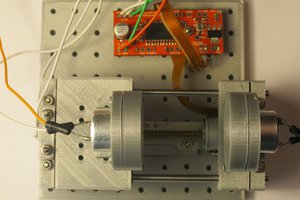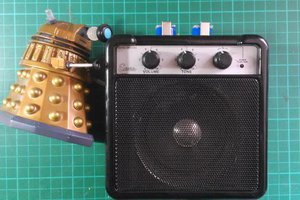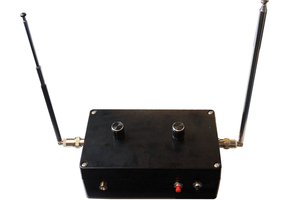ATtiny12L Selectable Frequency Generator
A low-power selectable frequency generator
A low-power selectable frequency generator
To make the experience fit your profile, pick a username and tell us what interests you.
We found and based on your interests.
I’ve worked with DDS generators in the past. One such use was with an AVR microcontroller, specifically, an ATmega168 running at 10 MHz .
In that particular project, I wanted to be able to generate frequencies that were higher than those that the AVR could generate on its own using DDS. The DDS sampling frequency was limited to <50 KHz because the sampling rate was 100 KHz. Using the Nyquist Theorem yielded approximately a stable 50 KHz waveform with a slight jitter due to the fact that the DDS generator used a timer interrupt to signal the DDS algorithm to update the internal 24-bit DDS registers. In practice, there was up to 5 clock cycles of jitter. The DDS output is a square wave and the resulting output is also a square wave.
Because I wanted to generate frequencies in the 300 to 500 KHz and 1 to 2 MHz ranges, I decided that a frequency multiplier would best serve that purpose. To that end, I came up with a method that employed the use of a PLL, of which the CD74HC7046A was a perfect candidate because it was low-power and would operate down to 2 volts and the power supply ran at 3 volts.
In the implementation, I wanted to be able to select a range of frequencies for the two different bands. The VCO would not cover the full range of 300 KHz to 2 MHz, so by using an output on the AVR, I was able to shunt a resistor in parallel with another to achieve selection of the two different bands of frequencies. A partial schematic is shown below.
Referring to the schematic above, leaving the AVR’s I/O pin set as an input essentially tri-stated the pin and thus had little effect on the fixed (and permanent) current mirror set resistor (R6), which enabled the VCO to run at the lower frequency range. Setting the I/O pin to a low output switched in the 2nd resistor (R5) in parallel to the first (R6), thus setting the VCO to oscillate in the higher frequency range.
The PLL needs a divider in the feedback loop to set the multiplier ratio. I realized that one of the 8-bit timers in the AVR could be used as a programmable divider, thereby creating a programmable multiplier. The formula for the divider ratio is (2 * (OCR[x] + 1)).
In the above circuit, DDSOUT is the DDS frequency generated by the AVR. TIMER0 was used as the divider. DIVIN goes to TIMER0’s input pin (T0), which is used as the clock source for the timer. DIVOUT is the OC0A ouput. An OCRA setting of “0” yielded a divide by 2, which translated to a 2x multiplier of the DDS signal. An OCRA setting of “1” yielded a divide by 4, which translated to a 4x multiplier of the DDS signal. BANDSEL is used to select the upper or lower bands of the VCO. The PLLEN signal was used to disable the PLL output so that frequencies in the 1 Hz to 50 KHz range could be directly generated by the AVR’s DDS output.
Referring to the schematic excerpt on the right, a single NC7SP157 ‘HC157 MUX (U8) was used to switch between the direct DDS and multiplied DDS outputs, which fed a complementary MOSFET output driver circuit comprised of Q1 and Q2. VPP is adjustable and sets the driver’s output level. In the actual circuit, VPP was driven by a MAX5026 boost-regulator, whose voltage setting resistor was via a MAX5463 programmable digital potentiometer under AVR control.
I decided to post some other useful frequencies that I have run across that others have verified seem to have positive effects. They are listed below. Note that the ATtiny12-based frequency generator described in this post is only capable of generating fixed frequency output. Perhaps adapting the code to implement a direct digital synthesis (DDS) sweeping method would allow one to obtain the resulting frequencies. Keeping in mind that the chosen DDS “sampling frequency” would limit the upper frequency range. Another choice may be to use an external DDS IC with a square-wave output, such as the ANALOG DEVICES AD9837, which uses an SPI interface.
Description | Frequency (Center or Low) | Frequency (High) | Delta F | Type | Duration (in minutes) | Step Rate (250mS/step): | Number of Sweeps (up and down) |
Love | 13,824 | fixed | 21.00 | 1 | 84 | ||
Virus/Parasite Sweep | 350,000 | 490,000 | 250 | sweep | 70.00 | 10 | 3 |
Bacteria Sweep | 285,000 | 390,000 | 250 | sweep | 52.50 | 6 | 5 |
Molds and Mildews Sweep | 75,000 | 300,000 | 400 | sweep | 56.25 | 8 | 3 |
Candida Sweep | 435 | 495 | 5 | sweep | 30.00 | 12 | 50 |
Lyme Sweep | 28,000 | 29,000 | 50 | sweep | 50.00 | 12 | 50 |
Fibroid Cyst Sweep | 990,000 | 1,150,000 | 250 | sweep | 56.00 | 7 | 3 |
General Pain Reliever | 16,936 | fixed | 60.00 | 1 | 240 | ||
Tissue Regeneration | 565 | fixed | 60.00 | 1 | 240 | ||
“Sticky” Blood Sweep | 62,500 | 67,500 | 50 | sweep | 26.67 | 16 | 4 |
Cellular Recharge | 880 | fixed | 60.00 | 1 | 240 | ||
Cramps | 111 | fixed | 30.00 | 1 | 120 | ||
Solfeggio – Angelic Skein | 111 | 1,555 | 111 | list | 30.00 | 1 | 553.5 |
Glaucoma Sweep | 12,728 | 12,828 | 10 | fixed | 45.33 | 16 | 68 |
Here are some “experimental” frequencies that I ran across.
Description | Frequency (Low or Fixed) | Frequency (High) | Delta F | Type | Duration (in minutes) | Step Rate (250mS/step): | Number of Sweeps (up and down) |
“Clark” Sweep | 2,250 | 2,750 | 15 | sweep | 45.00 | 12 | 27 |
Thyroid De-calcify | 122,300 | 123,300 | 77 | sweep | 30.84 | 15 | 38 |
Blood Pressure Reduction | 77,525 | fixed | 60.00 | 1 | 240 | ||
Type 2 Diabetes | 122,080 | 123,080 | 11 | sweep | 28.41 | 15 | 5 |
Pineal Gland De-calcify | 121,550 | 122,050 | 27 | sweep | 30.56 | 11 | 36 |
Mites Sweep | 641,000 | 781,000 | 280 | sweep | 62.50 | 6 | 5 |
Auto-Immune Strengthening | 140 | 200 | 5 | sweep | 30.40 | 16 | 38 |
Charged Water | 150,000 | fixed | 30.00 | 1 | 120 | ||
Food Poisoning | 12,484 | fixed | 30.00 | 1 | 120 | ||
Kidney Stone Passing | 999 | fixed | 90.00 | 1 | 360 | ||
Energy Sense Ability | 500 | 1,500 | 50 | list | 48.00 | 1 | 576 |
3rd Eye, Crown, Crown+1, Crown+2 | 852 | 1,285 | 111 | list | 16.00 | 1 | 984.5 |
Libido Elevation | 80 | 90 | 10 | list | 15.00 | 1 | 3600 |
Energy Transfer Block | 77,777 | fixed | 90.00 | 1 | 360 |
Over a decade ago, I was exposed to a new kind of technology. Well, rather it was old technology but I was newly exposed to it. Let me explain… Some one had asked me to research this subject on personal and private healing methodologies. Here’s what I discovered: Back in the 1920’s, a man named Dr. Royal Rife was looking for a cure for cancer. He found that he needed to invent a new light source for his microscope just to see the live cancer cells he was able to grow. He found out that there are two viruses responsible. He called them the BX and BY viruses, now known as Carcinoma and Sornoma. Once he could see the live cells, he could look for a way to kill them. He tried all sorts of methods but stumbled across frequencies. He found that when he exposed them to certain frequencies of a low energy electro-magnetic field, they would disintegrate. The claims are that he then “cured” many people of cancer and other diseases and tried to make the public aware of his findings through the AMA who criticized him and would not validate his research. He fought with the leaders of the AMA for many years and sometime in the 50’s died while in the hospital under “suspicious circumstances”. There is a book entitled “The Cancer Cure that Worked!” (ISBN: 0-919951-30-9) that tells his story.
I also ran across more information by a researcher who had studied and followed Dr. Rife’s work. Sometime in the 80’s, a woman named Dr. Hulda Clark, continuing Dr. Rife’s research, figured out which specific frequencies disintegrated all known pathogens to man at the time (bacteria, mold, mildews, parasites and viruses). She spent 10 years researching this and has published a few books. One is called “The Cure for All Diseases” ISBN#1-890035-01-7. I’ve found the book as a PDF file on the internet but it is missing all the photos. Better to just purchase the book which list price is @21.95. I think I purchased mine for $16. You can google “Hulda Clark” and “Royal Rife” for some info on that. She claims that she came up with a frequency and an electronic device, called a “zapper”, that she found was effective in eradicating all pathogens.
Further research led me to another man by the name of Don Croft. He is the “inventor” of “Orgonite” (Dr. Wilhelm Reich discovered Orgone in the mid 50’s). Don used to sell a unit of his own for US$125 called “The Terminator”, which emitted a frequency of 15 Hz. It was a “zapper” of sorts. When I researched it, he had lots of positive sounding testimonials from folks using these types of devices. His web site was http://worldwithoutparasites.com.
For more information, punch up “royal rife”, “hulda clark”, “zapper”, “frequency healing” on any web search engine.
After all that research, I was intrigued. My offspring were young and in PUBLIC school. The other children at school were always sick from something and on occasion, my offspring would pick up a cold or runny nose. I thought since the circuit was so easy to build that I would just build one to try it myself. After the build, I used it with my offspring a few times when they exhibited symptoms of some illness coming and they seemed to get better within a day or two.
I did some more research and found some web sites that were offering other frequencies for various conditions. Even Dr. Rife had published many frequency sets for a whole bunch of different conditions, some of which I had never heard of.
At that time, I was playing with the ATMEL ATtiny12L, an 8-pin MCU. I got the idea that if I could program the AVR to select and emit several different frequencies for various uses then I would be happy. Of all the frequencies I ran across and noted, I selected what I thought were the “top 5” and came up with a simple design...
Read more »
Create an account to leave a comment. Already have an account? Log In.
Other useful frequencies - https://wg100blog.wordpress.com/2016/12/18/other-useful-frequencies/
ATtiny12L Selectable Frequency Generator - https://wg100blog.wordpress.com/2016/11/08/first-blog-post/
Become a member to follow this project and never miss any updates

 Andrew Ferguson
Andrew Ferguson
 Sproket
Sproket
 Richard Nock
Richard Nock
 Filip Mulier
Filip Mulier
Some thoughts about using DDS with a PLL to achieve higher frequencies - https://wg100blog.wordpress.com/2016/12/19/some-thoughts-about-using-dds-with-a-pll-to-achieve-higher-frequencies/